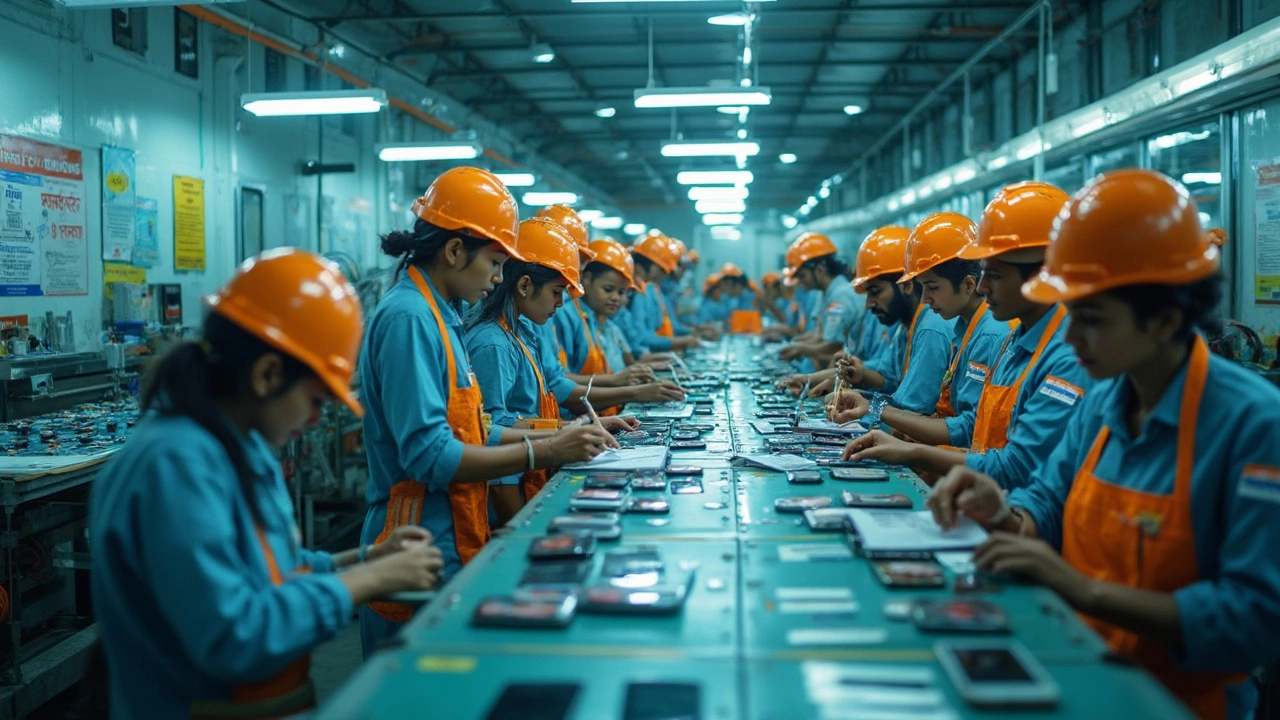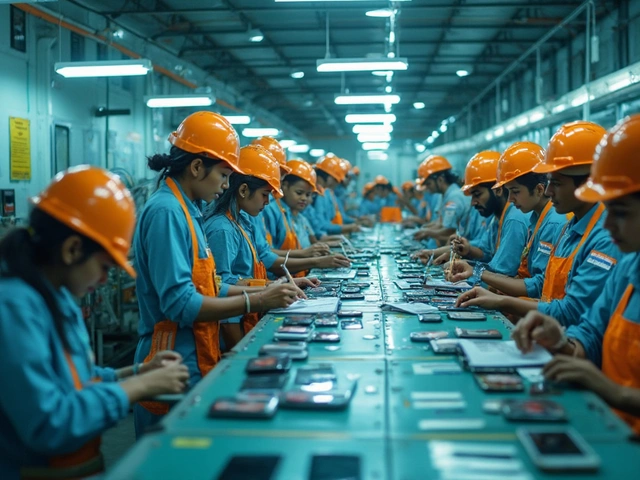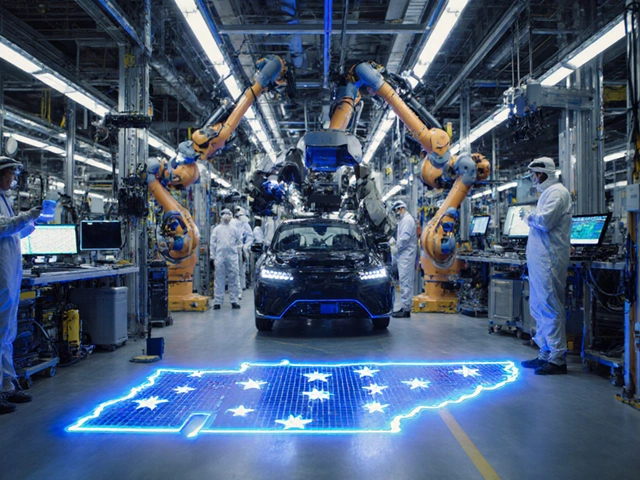Ask anyone who’s ever tried to launch a product—making stuff isn't just about clever designs or fancy machines. The guys really calling the shots are government bodies keeping watch every step of the way. Want to open a factory or roll out a new gadget? There’s a checklist of rules, permits, and surprise inspections before you even flip the switch.
The weird thing is, most people have no idea that entire teams at government agencies are focused on what’s happening on factory floors. Agencies like the FDA, BIS, or EPA don’t just watch from afar—they visit, measure, sample, and carry real power. Miss a step, and you’re looking at fines or forced shutdowns. So, if you’re dreaming about jumping into manufacturing, you need to know who these watchdogs are and how you can keep them happy—or at least out of your hair. The rest of this guide is built to make those rules and schemes finally make sense, so you don’t get blindsided by red tape.
- The Role of Government in Manufacturing
- Key Agencies and Their Power Moves
- How Standards and Compliance Really Work
- Government Schemes That Matter to Makers
- Common Challenges for Manufacturers
- Tips for Navigating the Oversight Maze
The Role of Government in Manufacturing
If you think manufacturing is just a business thing, think again. Government actually plays a huge part in what gets made, how it gets made, and even how fast you can get your hands on it. The main reason? It’s all about protecting people—making sure products are safe, factories don't wreck the environment, and workers aren’t put at risk.
Most factories can’t just open up shop wherever they want. There are building codes, safety inspections, environmental permits, and a stack of paperwork you can’t really dodge. In the U.S., for example, agencies like OSHA check on workplace safety, while the EPA makes sure factories aren’t dumping chemicals into rivers. And if you’re in the food, drugs, or tech business? Better get used to the FDA or the Department of Commerce dropping by.
- Manufacturing oversight means factories must follow the rules—or pay fines and maybe even shut down operations.
- Governments set rules for what materials can be used, how much pollution a plant can make, and how workers are treated.
- Regulations can cover everything from how tall a factory can be, to the snacks provided in break rooms (no joke—some places have rules on this).
Here’s a quick look at what different government agencies handle when it comes to manufacturing in the U.S.:
| Agency | Main Focus |
|---|---|
| OSHA | Worker health and safety |
| EPA | Environmental impact & pollution |
| FDA | Food, drug, and medical device safety |
| BIS (Commerce Dept.) | Tech exports, trade rules |
| USDA | Food safety, farm products |
Globally, things are even more tangled. Countries have different standards, and if you want to sell overseas, you’ll need to meet local rules too. For example, European countries have CE marking for products, and China has its own sets of rules. This patchwork means manufacturers can’t just make one thing and ship it everywhere—they’ve got to tailor products to each market's government schemes.
Don’t forget the carrot side of things: governments don’t just regulate—they also hand out incentives. There’s tax breaks for green manufacturing, grants for new tech, and even direct payments if you set up shop in a needy area. It’s a mix of rules and rewards, but either way, government is never far away from the factory floor.
Key Agencies and Their Power Moves
When people talk about who calls the shots in manufacturing, they usually mean the government agencies holding the rulebook. In the US, for example, the Food and Drug Administration (FDA) is front and center for anything related to food, medicine, or cosmetics. They decide if your cough syrup recipe ever makes it onto pharmacy shelves. Even tech products get a taste of oversight—the Federal Communications Commission (FCC) checks devices for radio interference while the Bureau of Industry and Security (BIS) manages export controls. If you want to ship your latest gadget abroad, you’ll need BIS paperwork.
Let’s not forget the Environmental Protection Agency (EPA). The EPA steps in hard if your manufacturing process releases pollutants or wastes that could harm people or the planet. They run regular checks and don’t shy away from big fines—even on major companies. Their say-so can mean extra equipment, new waste procedures, or a shutdown until things get fixed.
Here’s a quick hit list of the most active agencies (and what they control):
- FDA: Food, drugs, medical devices, cosmetics
- EPA: Air, water, and land pollution from manufacturing
- OSHA: Worker safety standards inside all kinds of factories
- FTC: Labeling, advertising, and market claims
- FCC: Electronic devices, radio-frequency approvals
- BIS: Export rules and regulation enforcement
If you’re outside the US, similar agencies play tough—like the European Medicines Agency (EMA) or India’s Bureau of Indian Standards (BIS—not the same as the American one!).
Some agencies have teeth, too. Last year, the EPA hit US factories with $1.6 billion in enforcement penalties for breaking pollution rules. That’s not pocket change, even for big manufacturers. The FDA blocked over 3,000 imports in 2024 due to compliance issues, according to their official database.
| Agency | Key Area | Major Action (2024) |
|---|---|---|
| FDA | Drugs & Food | Blocked 3,000+ imports |
| EPA | Pollution Control | $1.6B in penalties |
| OSHA | Workplace Safety | 20,000+ inspections |
If you’re running a factory or even just prototyping a new product, brushing up on rules from these manufacturing oversight agencies isn’t just helpful—it could save you thousands in fines or lost business. Don’t wait for a surprise audit. Get familiar with what they expect and stay one step ahead.
How Standards and Compliance Really Work
If you’ve ever wondered why your kid’s toy doesn’t break the first time it’s dropped, or how a food product lists its ingredients the same way every time, that’s not random. It’s because government-backed standards set the rules on how things get made and sold. Standards are basically instructions for products, covering everything from design and testing to labeling and packaging. In the US, if you’re in the medical device game, you’ll deal with the FDA’s Code of Federal Regulations (CFR). Want to export electronics? Say hello to the Bureau of Industry and Security’s export control lists. Construction? OSHA checks how hardhats are made, and even how ladders hold up.
When it comes to manufacturing oversight, compliance is more than just a box to tick. It’s a mix of paperwork, on-site inspections, lab tests, and, sometimes, recalls. And if you think nobody’s really checking, think again: in 2023 alone, over $4.2 billion in fines were handed out for compliance failures just in the US manufacturing sector. For global players, missing EU’s CE mark or India’s BIS certification can stop imports cold at the border.
What really happens on the ground? Most manufacturers set up quality assurance teams to check that every widget meets the standards before shipping. They run regular tests, track batch numbers, and keep records for years. Sometimes an outside auditor pops in, looks at your factory, and checks paperwork. If something’s off, you can get penalties, forced recalls, or even a total business shutdown.
Check out how some big standards stack up:
| Standard | Applies To | Enforcing Body | What Happens If You Fail |
|---|---|---|---|
| ISO 9001 | Quality management (all industries) | Internal/External Auditors | Lose contracts, hurt reputation |
| FDA 21 CFR | Food, pharma, medical devices (US) | FDA | Fines, recalls, shut down line |
| CE Mark | Electronics, toys (Europe) | EU Customs/Regulators | Blocked at customs, recalls |
| BIS Certification | Electronics, chemicals (India) | Bureau of Indian Standards | Import bans, legal action |
If you’re new to this, here’s what usually helps:
- Keep your documentation up to date and organized.
- Run your own tests before anyone else shows up.
- Train your staff so they know why these standards exist, not just how to pass a check.
- Talk to someone already in your industry—real-world advice beats Google searches every time.
There’s no skipping compliance. If you think it’s a headache, imagine dealing with a nationwide recall or legal fight instead. Standards might seem strict, but they save companies—and everyone else—a ton of trouble down the line.

Government Schemes That Matter to Makers
If you’re messing around with manufacturing in the US, you’re gonna run into more government schemes than you might think. These aren’t secret plots—they’re programs, incentives, and support systems made to boost factories, cut pollution, or just make sure everyone’s playing fair. The trick is knowing which ones really move the needle.
Let’s start with the Manufacturing Extension Partnership (MEP), a national network run by the National Institute of Standards and Technology (NIST). The MEP doles out funds, training, and consulting to small and medium manufacturers. More than 30,000 companies tapped into it in 2023 alone, scoring nearly $18.3 billion in new sales, according to NIST. MEP centers cover all 50 states—so there’s always someone local to ask for help.
Then there’s the Small Business Innovation Research (SBIR) and Small Business Technology Transfer (STTR) programs. These offer government grants to help startups and small businesses get products from idea to reality. If you’ve got a new process, machine, or gadget, SBIR and STTR can mean the difference between hustling in your garage and ramping up for real. In 2024, SBIR dished out more than $3.2 billion across thousands of winners.
Don’t forget the incentives tied to energy and the environment. The Department of Energy’s Advanced Manufacturing Office hands out grants for projects that boost efficiency or use clean tech. Back in 2022, they funded 35 pilot projects that cut average plant energy use by 12% per location. Plus, if you’re making electric vehicle parts or solar panels, there are federal tax credits up to 30% (see the Inflation Reduction Act of 2022 for the nitty gritty).
Here’s how some of these manufacturing oversight programs stack up:
| Scheme | Who Can Apply? | Main Benefit | Recent Data |
|---|---|---|---|
| MEP | Small/Medium US Manufacturers | Consulting, training, local support | 30,000+ firms in 2023, $18.3B in new sales |
| SBIR/STTR | Startups, tech companies | Grant funding for R&D projects | $3.2B awarded in 2024 |
| DOE AMO Grants | Manufacturers focused on energy savings | Project funding, tech adoption | 35 projects, 12% average energy savings (2022 data) |
| Federal Tax Credits | Clean energy manufacturers | Up to 30% tax credit | IRS data, ongoing |
If you’re a maker, don’t assume these schemes are just for corporate giants. They’re set up for regular folks and family businesses too. Quentin and I learned the hard way that paperwork is a pain, but the payoff is real. My tip: line up your paperwork and keep an eye on deadlines—most grants and credits run out fast. Start with local MEP offices or check the federal grants website to see which programs fit your operation best.
Common Challenges for Manufacturers
If you ask any factory manager what gives them a headache, government rules are likely near the top. Staying on the right side of manufacturing oversight isn't as easy as just following instructions. Regulations can change every year, sometimes more. For example, the United States Environmental Protection Agency (EPA) might update how much a chemical plant can release into the air. If you aren’t watching, your perfectly legal process from last year could get you fined tomorrow.
Then you have the paperwork pile-up. Every agency wants forms, reports, proof of safety checks, training logs—you name it. It’s not just one and done. The FDA, for example, will demand documentation for every batch if you’re making food or medicine. Mess up your files, and the inspection can turn into a shutdown. That’s why a lot of big companies now hire entire teams just for compliance—to keep the doors open.
Another thing? The rules aren’t the same everywhere. Make a toy in Mexico, sell it in Europe, and you’ll hit the famous "CE" mark regulations (and those require a whole load of testing that the US doesn’t). Some factories lose money fast because they build to the wrong standard and can’t sell where they planned. Even giants like Samsung or Ford have landed in hot water for products that missed a country's new safety rule by a few months.
Tech keeps shifting too. When new machines or materials hit the market, regulators are sometimes slow on the draw, and manufacturers get stuck guessing what counts as "safe enough." If you’re a smaller operation, making sense of new rules or technologies is even tougher—you probably don’t have lawyers on call.
Here are some tips for getting through the red tape without tanking your business:
- Check official government websites every few months for rule changes.
- Invest in digital record-keeping—the more organized your files, the less you panic during audits.
- Train your team like it’s part of the job, not a nice-to-have. People skipping steps is the fastest way to get fined.
- If you’re selling overseas, double-check local compliance rules before building your product, not after.
- Don’t be afraid to ask for help. A five-minute call with an inspector saves way more trouble than winging it.
Yeah, all this oversight can feel like a hassle, but it’s the difference between building a solid business and getting caught in endless shutdowns and recalls.
Tips for Navigating the Oversight Maze
So, you want to stay on the right side of those dreaded regulators? Don't just hope you’re doing things right—get organized. The rules change fast, paperwork piles up, and random inspections are a fact of life in manufacturing oversight. Smart teams know that just winging it is a recipe for disaster (and possible shutdowns). Here’s how the pros survive.
- Know Your Agencies: Don’t mix up what OSHA wants with what the EPA enforces. Each agency has its own list of ‘absolute musts.’ For example, OSHA nailed over 2,600 manufacturing sites with fines in 2024 just for safety lapses. Make a cheat sheet for the main agencies affecting your operation.
- Build Compliance into Your Daily Routine: Treat paperwork as serious as payroll. Automate reports or use digital checklists—this isn’t busywork, it’s your best protection. In one U.S. survey, 86% of manufacturers using automated compliance tools reported fewer violations than those doing things the old way.
- Stay Updated (or Risk Getting Burned): Regulations can shift overnight. Sign up for government alerts, follow trade associations on social, and review the latest compliance emails every Monday. The FDA, for instance, made three major rule changes in just the last twelve months.
"Regulatory compliance is not a 'set it and forget it' job—companies who see it as ongoing are the ones who thrive." — Michelle DeWitt, Industrial Compliance Expert, 2024
It’s also just smart to have a go-to person on staff who tracks rule changes. If your company can swing it, consider hiring a compliance manager or bring in an outside consultant once a quarter for a quick audit.
| Agency | Main Focus | 2024 Major Updates |
|---|---|---|
| OSHA | Workplace safety | New machine-guarding standards |
| EPA | Environmental impact | Stricter emissions limits for plants |
| FDA | Product quality & safety | New labeling rules for foods |
| BIS | Export controls | Added parts to restricted list |
Don’t forget to talk straight with your regulators, either. If something isn’t clear, just ask. Most inspectors don’t bite, and a quick call today can save stacks of headaches later.






